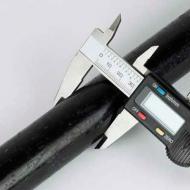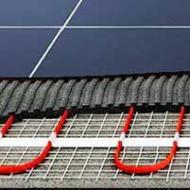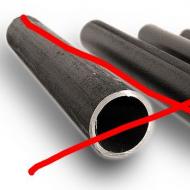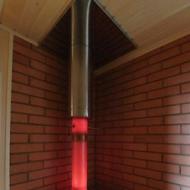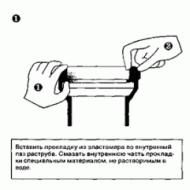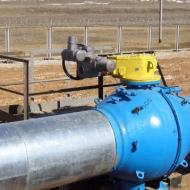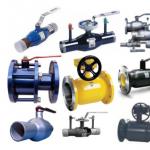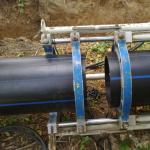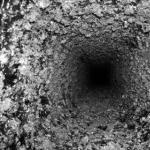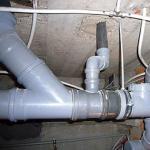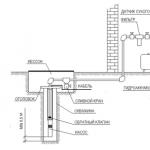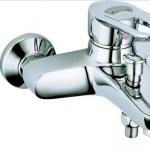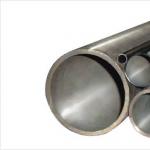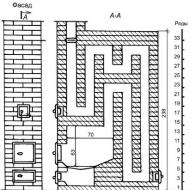
Pipes for cold water supply for home. Choosing the best pipes for water supply
When building a house or repairing an apartment, you often have to decide which pipes are better for water supply? Reply to it is not so simple, because the range of products offered by shops of building materials is quite wide.
If the construction of the house can be guided by instructions in the project (as a rule, there are indicated the dimensions and materials of the pipes), then during the repair all difficulties of choice lie on the shoulders of the owner.
The pipe market is diverse enough to make it difficult for the inexperienced in the construction business to make the right choice.
As a rule, homeowners are guided by three main indicators, these are:
- Technical characteristics of pipes;
- Quality;
- The cost.
And if the repair is planned to be made independently, then it is necessary to take into account also such factor as the complexity of installation and the opportunity to purchase the equipment that will be needed for repair.
Naturally, everyone wants to create a reliable system in the house, which, moreover, would be repairable. After all, from the emergence of an emergency situation, nobody is insured, therefore repair of the pipeline should not be excessively difficult and expensive.
Possible options

Before deciding for yourself what are the best pipes for water supply, it is worth to familiarize yourself with the options that you can use in your home and evaluate their positive and negative sides.
So, today for the pipeline of water supply apply:
- Steel pipes. These products can last approximately 25 years.
- Pipes made of stainless steel - this material will serve up to half a century.
- Pipes made of copper - the most "long-playing" option, the pipes can last 70-100 years.
- Metal-plastic - service life 25-30 years.
- Polyethylene pipes - about 50 years will not require replacement.
- Polypropylene pipes - will last more than 30 years.
Pipes from metal

Answering the question, pipes for water supply - which is better, some homeowners prefer to choose the traditional material - carbon steel, which was widely used in the construction of pipelines in multi-storey and private houses.
Advantages of steel pipes
However, to get the same durable result as it was in the Soviet era, it is possible only if the pipes are of high quality.
When using counterfeit, it is not necessary to count on the service of the pipeline for tens of years (however, the same can be said for pipes made of any other material).
In addition to durability, the merits of steel pipes include:
- Ability to withstand high pressure of the medium supplied.
- The ability to "keep" the temperature well, even if hot water is supplied with parameters exceeding the standard 60 degrees.
- A low coefficient characterizing the linear expansion of the steel makes it possible to dispense with the installation without the installation of expansion joints.
To the disadvantages of this type of pipe should be attributed fairly complex installation. If the work is planned to be carried out independently, then it will be necessary to purchase a welding machine, which is irrational for carrying out one-time works.
Pipes made of stainless steel

Pipes made of stainless steel will last longer than regular galvanized pipes. Such pipes are perfectly suitable for the construction of external and internal water supply networks.
They have the same advantages as the pipes made of carbon steel, in addition:
- Do not have any effect on the quality of the water supplied through them. After all, everyone knows the situation when water coming from a conventional steel pipe receives water with an admixture of "rust".
- Stainless steel pipes are convenient in operation and installation, which distinguishes them from pipes made of other metals.
Relatively rare use of such pipes during repair and construction is explained by their rather high price.
Pipes made of copper

If the choice of material to focus on durability and not take into account the cost, then the answer to the question: water pipes - which is better, the answer will be unambiguous.
Pipelines from copper can be mounted for both hot and cold water supply. This choice of pipes will help to forget about the problems with the water supply for almost a century! This reliability is facilitated not only by the durability of the material itself, but also by the mounting technology itself.
What are the methods of joining copper pipes today?
- The most reliable and, at the same time, very fast method is to use express.
With this method of installation, the human factor effect is minimal. The installer simply puts the fitting on the joint of the pipes and, using press jaws, performs the pressing. - Another method of connection is a high-temperature or, alternatively, a low-temperature one. This method of installation requires not only the availability of special equipment, but also sufficient professional skills.
The disadvantages of choosing copper pipes include:
- High cost of material;
- Impossibility to perform the work independently, since it is unlikely that someone will purchase expensive installation equipment for a single work.
- The need to take into account the compatibility of copper with other materials.
If it is planned to connect steel and copper pipelines, it should be remembered that the steel part can be only up to copper, taking into account the direction of the water flow.
Pipes from plastic

Plastic pipes today are at the peak of popularity, thanks to their affordable price and good performance. Especially popular is the choice among those homeowners who plan to do all the work themselves. Installation of pipes from plastic is easy enough, in addition, it is not required to purchase expensive equipment.
Pipes from polyethylene
This version of the pipes is excellent for the installation of a cold water supply line.
To their pluses it is possible to carry:
- The ability to maintain its strength even at low temperatures. Even if the water in such a pipe freezes, the integrity of the pipeline will not be disturbed.
Such pipes are the best choice for country houses and cottages with non-permanent heating.
- Pipes are easy to assemble, they are light in weight and able to withstand various loads.
If you choose pipes made from so-called cross-linked polyethylene, they can be safely used for hot water supply.
Pipes from polypropylene
![]()
If the choice of plastic products raises the question of which pipes are better for hot water, it is worth choosing a polypropylene product. Such pipes perfectly withstand water supply at temperatures up to 100 degrees, so they can be safely bet on feeding both hot and cold water.
Pipes from металлопластика
These are pipes that have a metal frame inside them in the form of a spiral or a perforated pipe. Such pipes have all the advantages of plastic (light weight, simple installation, ease of operation, etc.), and in strength not inferior to pipes made of metal.
conclusions
Thus, to say unequivocally, which pipes will be the best, is quite difficult. When choosing a particular material, it is necessary to take into account the conditions in which the pipeline will be used and the material capabilities of the homeowner. The most important condition for choosing pipes from any material should be the availability of documents confirming that the selected product meets the quality standards.
The choice of pipes for a water pipe is a very important issue that must be addressed when building a system in an apartment or a private house. To the pipes there are a lot of requirements: they must be durable, reliable, affordable and easy to install.
Metal and plastic pipes correspond to these requirements. Both options are quite extensive range, so the choice of the optimal material, suitable for a particular situation, is quite possible. In this article, we will talk about which pipes are better for a water pipe in the apartment.
Metal pipes
One of the main disadvantages of metal pipes is too much weight, which is caused by the difficulties arising in the process of transportation and installation of products. Installation of pipes is carried out by means of one-piece (welding or soldering) and split threaded connections. The use of a detachable connection simplifies further system repairs by simply replacing damaged parts of the structure.
It is extremely unprofitable to use ordinary steel pipes in a water pipe - this material has practically no corrosion resistance, so the pipeline starts to rust. In addition to the fact that because of this the system will begin to break down at an accelerated rate, so also the water in the tap will have a characteristic color and taste of rust.
When transporting water, pipes from steel begin to leak rather quickly and lose their tightness, so they have to be changed. Another negative factor associated with rust is the raid on the internal surface of the pipeline, because of which its throughput is reduced. So it turns out that with high mechanical strength and heat resistance, steel pipes are undesirable to use for water supply.

Quite another matter - galvanized pipes for water. The cost of such pipes is an order of magnitude higher than the cost of steel products, but it is clearly justified. The most important advantage of galvanized steel is its resistance to corrosion, which eliminates all of the disadvantages associated with this factor. However, a lot of weight is inherent in this type of pipe, so their installation can not be called simple.
The best option for metal pipes for water supply are copper products. They are distinguished by a very high cost and a considerable number of advantages. The service life of copper pipes is quite high, like safety (though there is a nuance associated with the appearance of copper oxides, but this phenomenon is not found in every case). Also, this material is inherent in the traditional complexity of metal pipes - soldering copper pipes can not be attributed to simple processes.
Plastic pipes for water supply
A modern alternative to metal products is plastic pipes, which have a lot of advantages and advantages in comparison with more traditional steel analogues. In particular, polymer products have a low weight, simplifying transportation and installation, are characterized by good performance characteristics and low cost.

There are two main types of plastic pipes used for water distribution:
- Polyethylene;
- Polypropylene.
It is worth considering both types in more detail.
Polyethylene pipes
One of the materials used to make plastic pipes is cross-linked polyethylene, which due to its special production technology has increased strength characteristics without loss of flexibility and elasticity. There are also low pressure HDPE pipes, but they are not very suitable for use in an apartment.

In addition, this value is not limiting - the destruction of polyethylene pipes begins only if the water temperature exceeds +110 degrees.
An important quality of polyethylene pipes is their plasticity. The water supply, assembled from such pipes, does not collapse even during freezing, which is especially important for private houses. In flats, the flexibility is more relevant, which allows to give the pipeline the necessary shape.
Polypropylene pipes
If the budget allocated for construction is not too large, polypropylene pipes will be a good option for equipping the water pipeline. They are cheaper than other polymer products, and in terms of performance they even outperform them: the working temperature of polypropylene is +95 degrees, and the pressure is up to 20 atmospheres. In addition, it is worth noting and the service life, which on average is about 50 years.

The disadvantage of polypropylene products is the lack of plasticity, so the installation of the pipeline at an angle is possible only with the help of appropriate fittings. Non-detachable connections of such pipes are carried out by means of a special soldering iron. In any case, before buying, you need to carefully understand what kind of propylene pipes are better for a water pipe, and prepare the equipment necessary for installation.
Metal-plastic pipes - which is better
Thermal resistance of metal-plastic pipes varies depending on the technology of their production. Pipes that are marked in blue are suitable for transporting water, the temperature of which does not exceed 30 degrees, and the white pipes are designed for use in hot water systems.

Compression fittings of various types are used for the installation of a metal-plastic pipeline. Connections using fittings with a compression ring can only be performed in an open way to provide access to the site for regular fitting of the fitting.
The diameter of the pipes for the plumbing in the apartment
Of course, increasing the diameter of the pipes entails increasing the cost of the system, while a too narrow pipeline will not have sufficient capacity. It will be best to find a "golden mean" and pick up pipes of the optimal diameter for a specific situation.

Calculate the diameter of the water pipe in the apartment should take into account the initial pressure and the degree of its reduction throughout the system. To measure the input pressure, a normal manometer will work, but even if it is not available, you can get approximate values. For example, if in apartments with three floors the head is normal, then the input pressure is at least two atmospheres.
The change in pressure in the pipeline is affected by:
- Number of different connections and fittings.
- Total length of the system.
- Presence and number of turns.
The pressure in the pipeline can not be less than 0.6 atmospheres, and the head taking into account normal delivery to the far point of the system must have a double reserve. If, considering these factors, install 12 mm plastic pipes, the only result will be a guaranteed reduction in system performance.
Much better fit pipes with a diameter of 16 mm - they will be enough for the normal operation of the water supply without loss of performance. To accurately calculate metal or metal-ceramic pipes for water supply, use special formulas, but they are quite complex, so they are used only by experts in the industry.

The piping in the apartment can be carried out in accordance with the standard scheme:
- As risers, pipes with a diameter of 1 or ¾ in. (25 and 20 mm) are most often used.
- The pipeline is directly piped by ½ or 3/8 in. (15 and 10 mm).
When choosing the diameter of water pipes for an apartment it is worth considering the following points:
- The internal diameter of polypropylene pipes is not directly related to the outer diameter (a half-inch pipe may have a lumen of 11 to 13 mm);
- The dimensions indicated in inches do not reflect the capacity of the pipes, which is especially important in the arrangement of a pipeline including both metal and plastic elements;
- Before installing polypropylene pipes, you need to study the technology of their welding, which will require appropriate instruction.
Nuances of installation of a waterpipe
Knowing what water pipes make of, you can get an idea of the features of mounting each material:
- Plastic pipes are much more convenient and profitable. For them, there are many fittings, so the choice is extensive. Tightening of threaded connections in this case does not require serious efforts, which greatly simplifies the work. The all-in-one method of connecting the pipes will ensure the tightness of the structure with minimal labor costs for installation.
- To mount a pipeline of metal parts, special equipment will be needed: steel pipes are connected by welding, and for copper products, soldering kits are needed. If the connection is threaded, seals should always be used.
Conclusion
For water supply systems, you can use a wide variety of pipes, the choice of which directly depends on the operating conditions of the system and its features. There are metal and plastic pipes, the characteristics of which allow you to assemble any pipeline. When the question of which pipe is needed for the water pipe is closed, it remains only to choose the optimal pipe diameter for a particular situation.
One of the most common questions arising from people planning to equip their water supply system is which pipes are better for water supply and what to look for when choosing them.
Indeed, the choice of pipes is of great importance, it depends on them what kind of water supply will be, how it will be able to function, what loads it will carry, etc.
Contents of the article
How to choose?
Take, for example, standard water pipelines, available without exaggeration in every house. To assemble such a pipeline correctly, you need to correctly select its components.
The components here are the pipes themselves, fittings, and also various types. Nevertheless, the main influence is rendered by pipes, because only on them we are oriented, then buying connecting fittings, adapters and other useful parts.
To make your choice correctly, you need to pay attention to several things at once. The choice of pipes is not a choice of beautiful clothes. It is important here a clear calculation, consideration of the parameters of the future system, its specific features, features and approximate characteristics.
If you buy, for example, plastic water pipes for hot water systems, and they, for example, are able to keep the temperature of the carrier to +40 degrees, then this is fraught with big troubles in the future.
Obviously, I would like to avoid such situations. That's why making a choice of components, people look only at a few basic characteristics.
These include:
- material;
- diameter indicators;
- level of the maintained pressure;
- temperature regime.
There are also additional parameters, but they are not so important for implementation, so they are often reclined or taken into account as the last arguments.
Evaluation of material and characteristics
First of all, of course, try to choose the pipe material. The material depends, if not all, then very much.
The material of pipes of a waterpipe by and large defines their characteristics. For example, the operating temperature level for steel pipes is almost unlimited, but plastic or polypropylene is not so reliable in this respect.
Among the most popular materials are groups:
- Metal.
- Plastic.
Both the first and the second have their own characteristics, nuances with their pluses and minuses.
Metal
The main feature of metals is the highest strength. Metal products are difficult to damage, they withstand enormous physical exertion, can act as products of the most varied diameter, from the minimum to the maximum.

At the same time, the strength of the workpiece will not depend on the diameter, that is, it is permissible to use pipes in any part of the water pipe. The metal problem is weight and not very convenient installation.
Among metal products, it is worth choosing between products:
- steel;
- brass;
- copper.
Steel - the most popular option, previously virtually unparalleled. Now its popularity has strongly subsided, because of occurrence of polymeric analogues.
Steel pipes, although very reliable, but extremely susceptible to corrosion. Over time, they are destroyed, with constant contact with water, the process of destruction only accelerates.
In order to avoid premature damage, steel waterworks are galvanized or made of stainless steel. Such solutions can not completely relieve you of the problem, but they can postpone it.
Brass pipes are rare, more often brass is used when manufacturing various kinds of fittings and adapters. The main advantage of brass is full tolerance to contact with moisture, etc.

It is better to choose only people who have a decent budget and understand exactly what they need. Copper is an excellent metal. For the assembly of the water pipe it fits perfectly. What is just the fact that in some European homes remained fully functioning, the account of which has exceeded a hundred years. Is this not an indicator?
What can be a little embarrassing you when buying, is the price of copper pipes. It is very high, several times higher than steel and brass.
Plastic
Plastic products - a product of modernity. Since their appearance, some time has already passed, but they are still holding the leadership position and will hold on for a long time.
The uniqueness that plastic pipes have is a combination of chemical inertness along with sufficient strength, ease of installation and ease.
Plastic blanks are very durable, do not react in any way to external stimuli, they are easily assembled together (the process of welding them and turned into a usual combination of fittings in a heated form does not almost weigh anything). And this is at a fairly low, or at least, winning at the metal analogues price.
Considering polymer materials, you should pay attention to the pipes:
- polypropylene;
- polyethylene;
- polyvinylchloride.
Polypropylene samples are intended for water supply of cold and hot water supply. Reinforced polypropylene pipes can be used even when assembling heating systems.
- more reliable and stronger than all others. The polypropylene pipes are also much more expensive, but their money fully pays off.

Pipes made of polyethylene are designed for installation in cold water supply and sewage systems. They are divided into low and high pressure polyethylene pipes.
HDPE or low pressure polyethylene should be chosen, for example, sewerage or branches of water supply from pumping stations. LDPE is softer, but not subject to the negative influence of high temperature conditions and works well even in systems with a serious level of nominal pressure.
PVC or PVC pipes are products from soft cheap plastic. From PVC, by virtue of its features, it is reasonable to design unless internal sewerage or branches of transportation of cold water.
Suitable diameter
The diameter of the pipe depends on where and how it will be applied. Also all the related products depend on the size of the diameter or internal section.
Any fitting, return pipe, workpiece, adapter - all these parts must fully meet the size of the diameter of the target model.
If we bought pipes with a diameter of 50 mm, then fit them only fittings with the same diameter. In rare cases, use adapters from one diameter to another, but they are used more as an exception.
The diameter of a product depends on the performance of a particular product, that is, the amount of carrier it can transport per unit of time.

Samples with a cross-section up to 50 mm are used for laying small branches of water supply and heating, pipes from 50 to 100 mm are nodal branches, the water of which is then distributed among several daughter nodes. All that is more is the main or central pipelines delivering water to several large points at once.
Do not overdo it with the size of the section and overpay. Choose an option that is right for you.
Operating pressure
With the pressure is still easier. In any water pipe, the pressure is formed constantly, without it we simply will not be able to deliver the water to the end user.
It is necessary to choose pipes so that their working pressure level was equal to or exceededmark the working pressure in the pipeline.
If the opposite is true and the pressure level in the pipeline is higher than the acceptable level of pressure in the pipe, then it is fraught with its destruction or excessive wear.
Do not go into extremes and buy the strongest pipes with a pressure resistance of 20 bar, if your pipeline produces only 10, and you do not plan to seriously upgrade it.
The difference between a pipe of 20 and 10 bar in price is very significant. Overpay you, by and large, there is no need. The water supply from such solutions will not be more effective.
The construction market presents a large number of various pipe products from well-known manufacturers. Therefore, in order to get the best option for quality and cost, it is very important to understand how to choose the best pipes for water supply to an apartment or a country house. The analysis given in the article will help to cope with this task.
Types of pipe products
The task of each developer is to choose the most optimal option for the price-quality ratio of pipeline products for the organization of the water supply system. To answer the question, which pipes are better for water supply, consider the pros and cons of each.
Depending on the material used, the pipes are:
- Plastic, which are divided into products made from:
- polypropylene;
- metal-plastic;
- polyethylene;
- polyvinyl chloride (PVC).
- Copper.
- Steel, made of:
- black steel;
- the zinced steel.
Polypropylene pipes
The most popular plastic pipes are polypropylene products. Widely used such pipes for, as well as for the transportation of hot water. Reinforced polypropylene pipes can be effectively used in high-pressure systems. Polypropylene products are positively different:
- ability to withstand the temperature of the working medium up to 90 ° C;
- low cost;
- long service life (over 50 years);
- simple pipe connection technology with;
- sealed and strong connections;
- possibility of use, both for outdoor and indoor (hidden) water pipes.

Pipes from металлопластика
Optimal for hot water supply, as well as for cold water supply when installing internal water pipes. The presence of metal in the composition does not prevent the pipes from having a certain flexibility. Positively characterized by such pipes:
- small cost;
- simplicity of installation;
- no need to purchase additional equipment for connection.
Among the shortcomings can be identified:
- the possibility of destruction at low temperatures;
- the need for constant monitoring and periodic tightening of the connections on the thread;
- the need to use expensive metal fittings.
Polyethylene pipe products
Thanks to frost resistance, in addition to the internal water pipe are used. Products for hot water supply are made from dense cross-linked polyethylene. In addition, these pipes are different:
- good plasticity;
- resistance to kinks;
- the ability to make connections using fittings.
As a drawback, it can be noted the increased cost of dense cross-linked polyethylene.

PVC Pipes
Pipes made of polyvinyl chloride in view of the chemical activity of the material and the release of harmful components are not suitable for use in apartments and other residential buildings. At industrial facilities such pipes are in demand due to low cost.
Copper products
The copper pipeline is the most environmentally friendly and durable, and also has a long service life (up to 100 years). Paving copper pipes, you can not worry about its reliability. However, copper pipes for inland water supply have two significant drawbacks:
- relatively high cost;
- the need for professional welding.
In addition, copper is chemically incompatible with pipes made of galvanized steel.

Steel products
Before the advent of plastic products, steel pipes were the most classic and popular option for laying water supply systems. Products made of galvanized steel are characterized by increased resistance against corrosion and high enough strength.
Choosing the best PP pipes
As can be seen from the above analysis, polypropylene products are optimal for the water supply. They are most in demand among developers. For correct selection of pipes, the following points must be observed:
- After the calculation of the number of pipes, and also based on their financial capabilities, determine the manufacturer.
The pipes from manufacturers from Germany are considered as the most qualitative and reliable. Not bad as an economical version of the product from Czech and Turkish companies. Chinese and Russian are much cheaper, but much inferior in quality.
- Pay attention to the marking of the pipe, where the working pressure is indicated, on which this product is designed.
- For hot water supply, it is necessary to choose pipes that indicate the maximum operating temperature of the working medium for which they can be transported.
- Select the pipes of the required diameter, which must match the diameter of the pipes of the inlet riser.
Thus, by orienting yourself which pipes to choose for water supply, you can mount the most reliable, efficient and at the same time cost-effective water supply system for your home.

